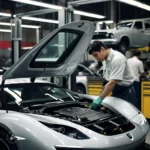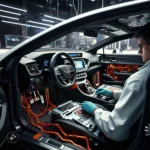Continuous efforts of energy conservation has seen big strides in different areas especially the automotive industry, towards meaningful sustainable solutions. Solar-powered cars are one of the many advancements that comprise this future, and a technology which seeks to marry renewable energy with transportation. With growing worries of climate change and fossil fuel depletion, the idea again warrants discussion.
Solar Powered Cars Summary
Sun-rays are converted into electric power through photovoltaic (PV) cells in solar-powered cars. That electricity is used to power the car’s electric motor, which helps reduce reliance upon fossil fuels and lowers overall greenhouse gas emissions. Although the idea of a solar-powered car was first trotted out in the mid-20th Century, over the last few years advancements have been made with enough benefit to warrant its implementation on newer cars.
Solar-Powered Cars Headway in Technologies
Photovoltaic Efficiency
The efficiency with which the photovoltaic cells — some of other most snowflake panels on a car, and working to capture sunlight only when directly above them–can convert sunlight into electricity is one of the single most important aspects of any solar-powered vehicle. Today’s high-efficiency solar cells are able to convert more sunlight into electricity. Although silicon solar panels have long been the best option for solar energy production, advances in technology are making it possible to produce better results with products like:
- Perovskite solar cells: These have the potential of surpassing silicon-based cell but also much cheaper to manufacture. Efficiencies in excess of 25% have been demonstrated by recent research, making them a well-suited technology for automotive applications [1].
- Multi-junction Solar Cells: These cells use multiple layers and different semiconductor materials to absorb a more complete spectrum of sunlight. They could be 40%-efficient machines, but remain expensive to manufacture.
Integration and Design
In fact, even the implementation of solar panels has made great strides in how it can compliment the design language tiles unto vehicles as well Today, modern solar-powered cars are built for aerodynamics and the most efficient application of energy from a variety of sources. Key design innovations in these solutions include:
- Solar Roofs & Hoods – With the debut on both the car roof and hood, solar panels can be mounted across two major surfaces of a car resulting in more captured sunlight. That integration is manifested in vehicle models such as the Toyota Prius Prime with its optional solar roof.
- Lighter Materials: Utilizing lighter materials such as carbon fiber and aluminum to lower the weights of both cars winds up making them more efficient.
Energy Storage Solutions
Since solar energy is not available around the clock, efficient energy storage has an important effect on whether a car powered with it remains viable. Ever since, advancements in battery technology have further increased the efficiency and longevity of batteries utilized by these vehicles. Key developments include:
- Solid-State Batteries: A new battery technology we covered few weeks which provides up to 3x energy density and upto lifetime as traditional lithium ion batteries. They are a battery of the future as far as basing energy storage in cars.
- Supercapacitors (Still not the most used solution, but has a record of faster charge-discharge rates than batteries which could be unwittingly applied as some sort buffer for car energy burst)
Advantages of Solar Cars
Environmental Impact
Not to the mention possibility solar powered cars are just better for Earth’s environment, by decreasing dependency on fossil fuels and lowering greenhouse gas emissions. When electricity comes instead from the likes of solar power, both global climate change mitigation as well as reduction in air pollution can occur with benefits to all for cracked out cleaner and brighter mornings.
Energy Independence
Even though solar energy use in transportation is relatively limited, the potential benefits are large because it can reduce dependence on imported oil and other fossils. Such a transition can help strengthen energy security, creating more reliable and predictable sources of supply.
Cost Savings
Cost of Solar powered vehicles may be higher due to expensive technology, but over a long period duration saving can substantial. The higher immediate expense pales in comparison to the substantial long-term fuel and maintenance savings, so solar-powered cars are actually a very profitable investment.
Technology And Innovation
By introducing new solar-powered cars, the innovation and tech advancements in our automotive industry are propelled towards better prospects. These advancements could translate to better renewable energy tech for cars and even more possibilities in other industries making use of clean powerGov.
Disadvantages to Solar-Powered Cars
Low Efficiency Of Solar Panels
Though the efficiency of photovoltaic cells has come a long way, this is still holding back solar cell technology. The best solar cells today can only convert a fraction of sunlight into electricity. This impacts the mileage and overall efficiency of solar powered cars, notably in areas without intensively exposure to sunlight or due overcast weather.
Energy Storage and Range
Storing Solar in the Most Cost-Effective Way is Another Major Issue Battery technology has advanced to the point that they are now pretty efficient, but there still remains a need for more ubiquitous and lasting energy storage methods. As we all know, solar cars have significantly shorter ranges than conventional vehicles which can be a major turn off to potential buyers.
High Initial Costs
Solar-powered cars are still relatively expensive to manufacture, because of the high cost of materials and advanced technologies. This adds to the cost, which may act as a disincentive in price-sensitive markets. Although, as the technology matures and volume leverage improves its expected pricing should go down.
Infrastructure and Support
To make use of solar cars mainstream, we will need a charging infrastructure and maintenance facilities. Although there is an increasing infrastructure for electric vehicle (EV) charging, it needs to appertain the unique properties of solar cars.
Their efficiency is dependent on their location: solar-powered cars are most effective in regions with plentiful sunlight. Solar panels are dramatically less effective when they get only a mean amount of sun or endure long periods with overcast skies. This limitation pertaining to geographical locations can make a solar car impractical in some areas.
Market And Some Flagship Models Now
Lightyear One
This brings us to the Lightyear One solar-powered car as one of its most notable examples. The fully electric car is a futuristic vehicle with integrated solar panels in the roof and hood of enough power to yield up to 12 km per hour of sunlight. It has a range of 725 km on one charge which also uses solar energy in addition to the battery stored.
Sono Motors Sion
The Sono Motors Sion is tan urban solar car. Solar charging is also available as the car has some solar panels in its body The Sion also gets a bidirectional charging system that lets the car share its stored power with other devices or even feed excess energy back on to grid.
Aptera
Aptera – solar-powered car with futuristic design, light weight and aerodynamic focus Thanks to innovative solar panels, energy needs are supported by the sun with an available 1,000 miles of range on a single charge. In the solar-powered car market, it is one of a kind with its special design and hi-tech functionality.
Innovations and Future Prospects
Advanced Photovoltaics Products
Continued development of photovoltaic materials anticipate increasingly efficient and affordable solar cells. Materials such as perovskite and organic solar cells are also being explored in research studies for high percentage efficiency rates to reduce the production cost of this system which can further make it available for common users.
Integration with Smart Grids
These cars would be an integral part of the smart grid, able to flow energy in both directionsValidating. Solar-powered vehicles that don’t just predict but also give power back This two-way energy transfer could help make the electric grid more robust and efficient, creating a win-win for both solar cars and conventional power infrastructure.
Self-Regeneratively Powered E-vesicles.
Solutions similar to the one above backed with other new tech, such as solar-powered and autonomous driving technology being made continuously could lead us into a future that seems like an alternate route of possibility in transportation. The same ones would also be used to better optimize and plan routes and energy so that solar power can do its good work efficiently on self-powered (solar) vehicles.
Policies and Subvention Measures by the Government
Strong governmental states will help solar powered cars in being adopted if little incentives are implemented. Others, like subsidies and tax breaks for the consumer or support of research to make R&D money less expensive would all help prop up the solar-car market so it’s a better value both now over time.
Public Awareness & Education
For these cars to go mainstream, a lot of ordinary citizens must be well aware about the benefits and potential uses for solar-powered transportation. They can also launch educational campaigns, as well as offer public demonstrations to show consumers the benefits of using this type of vehicle and their mechanics, dispel any doubts concerning operation or reliability.
Conclusion
Solar power becomes more viable for electric cars as solar technology continues to improve and they become even better value, says the latest research. Although faced with both shortcomings, solar cars are too attractive as a viable solution for sustainability of transportation because along side the environmental friendly future that is brought by them; not to spark mentioning but independence in energy and cost-effectiveness. Solar powered cars are on the horizon with an endless list of advancements in research and development, paving a bright pathway for what it would hold true as a revolutionized automotive industry allowing us to coexist squeaky clean within our green planet.










